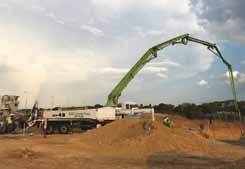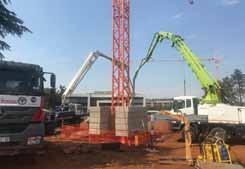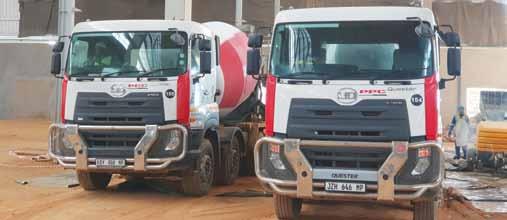
10 minute read
PPC Pumping
“In the event of a load being rejected by the operator, there are a number of options available. The worst of all options is to force it through the pump, because of the risk of a blockage and putting strain on the pump. This is a major safety risk. In this case the first accusation tends to be that the pump is at fault, when in fact the issue is most likely the pumpability of the concrete.
“The correct way to respond is to first determine the slump of that concrete. I would suggest every pump carries a slump cone to do an immediate slump test. If it falls within 110 to 135 slump, it should be most likely pumpable. If it falls outside that range, the operator should ask permission from the owner and concrete supplier to make adjustments to the batch, usually only 10ℓ or 15ℓ, or add some admixture without adding water does the trick. These are usually small adjustments required, and great care should be taken, but all too often the operator will simply put a hosepipe in without measuring and then there’s too much water added,” says Wolvaardt.
Advertisement
“The other option is to send it back to the plant, but that upsets everybody, because it’s a delay for everybody and a cost for the plant. Preferably it should be resolved on site, if possible. The need to dry it out on site – which is the case very often – is slightly more tricky would involve adding cement.
“It is important to get permission before making adjustments, in which case the contractor can still keep the guarantee on that concrete by adding a specified amount of water or cement. Then the volume of water needs to be properly measured in a 20ℓ bucket. It thereafter takes five to ten minutes to mix everything thoroughly. overseas they have flow meters on every readymix truck so one can measure how much water is added, but in South Africa this is not done.
“Another challenge with pumpable concrete is where the blades in the mixer become worn out, in which case they don’t thoroughly mix. This can result in lumpy cement which doesn’t offer the required adhesion and lubrication. To determine the cause of segregation is not easy – it could be one or several of many possible factors, such as too much or too little water, the blades or the pump.
E & G Concrete Pumping provides the entire service to contractors: the pumping, sale of new equipment and spare parts and rents out concrete pumps. “We’ve got a fleet of 16 concrete pumps, including 48m all the way down to 20m.
“operating a pump is in fact extremely simple - like playing Playstation – but what’s more important is understanding concrete and being able to manage difficulties as they arise with the concrete. The biggest challenge comes when one gets a blockage. It is vital to have an experienced person in charge of discharging the concrete into the hopper, to see what goes into the pump, so that one can react as soon as a problem occurs” says Wolvaardt. n

Boom vs static pumps
By Eamonn Ryan
Due to the level of specialisation required for pumping concrete, PPC has made a strategic decision not to own any pumps and to rather maintain a pool of approved pumping contractors to deliver its concrete on site when pumping is required. “In South Africa roughly 30% of our concrete is pumped, with the rest being either straight discharge or by crane,” says PPC Materials executive, Dave Miles.
On the central question of why to pump at all, Miles explains: “There are a number of reasons but the biggest one is time saving. Pumping is a lot faster than a crane. you can put the concrete exactly where you want to. Therefore, from the contractor’s point of view, a pump saves a significant amount of time compared to using a crane. Taking into account the fast-track nature of most projects these days the pump has become indispensable on any construction site.
“In addition, from a ready-mix point of view one gets faster turnaround on the trucks when they go to a pump. one can send a truck to a pump and ten minutes later it’s empty on its way back to the plant for another load. If one had to do that same load with a crane, the truck could be on site for an hour and a half to two hours. This results in better utilisation of the ready-mix producers assets.
“The customer gets a one stop shop with us whereby on their behalf we deal directly with the pumping contractors. This is something we found to be a much more effective operating business model and allows us to focus on producing high quality concrete. The brand of pump is the contractor’s concern, while customer relations remains our concern – as far as they are concerned they are always dealing with PPC, and we are answerable for the job quality,” adds Miles.
“The most important thing when selecting a pump is to first establish where the concrete must be placed, whether the job is at ground level or a high rise. When many people think of a concrete pump, they automatically think of a boom pump because it looks impressive. However, a boom pump is not always the best solution. If it’s high up, then a boom pump generally gets utilised more than a static pump. yet


if you take for example, the burj khalifa in Dubai, the tallest building in the world, it was built with a batch of static pumps, not with boom pumps. That building is 800m high and no boom pump can reach that high. Furthermore, the majority of static pumps can operate at higher pressures allowing them to pump concrete further distances than a boom pump.
“With burj khalifa, the contractor mounted permanent pipes onto the structure and pumped absolutely everything on the entire project as the quickest solution, using some extremely specialised pumps because of the height that they had to pump. using a crane would have been too slow and not cost effective,” says Miles.
“In the case of a long-term project such as a high rise, it makes better sense to utilise a static pump and just add pipes as the building rises. However, at the moment few if any real high rises are being constructed in South Africa, and if one looks at the rate at which concrete is placed, the boom pump does make more sense for its convenience. one can do one floor at a time, taking it off site between floors to do other jobs and periodically returning. This practice does reduce the operating costs for the contractor as he does not incur the full cost of the pump when it is not in operation. He only pays when he needs it making the cost a totally variable one.
“Every pump has a different performance level: just because a pump has a long boom of 46m or more doesn’t mean it pumps faster. Generally, static pumps are used where there is a requirement for flows over long distances. They tend to run at higher pressures, thereby pumping further or higher. Many of the 46m booms have a theoretical pumping capacity of 60m3 an hour, and in reality only achieve around 40m3 – which at 100 tons an hour is still a lot of concrete. but a static pump can push up to 120m3 an hour, which no boom currently available in South Africa will achieve.
“In the case of a boom pump, ground conditions are critical as the pump and boom create a massive counterweight load with the booms jutting out 46m. They require well compacted substrates and must be level. If one places a boom pump on a 10 degree slope it may fall over. Access is critical and should preferably be sufficient to allow two ready-mix trucks in at a time. This is a point that is often overlooked by the contractor and one ends up with a underutilised pump as a lot of time is spent moving ready-mix trucks around.
“With a static pump, ground conditions and site conditions aren’t as critical because there’s not a huge load being applied to the ground. This means the pump can be placed out of the way as long as trucks can have easy access,” he says.
CONCRETE PuMPS ARE HigH ON MAiNTENANCE
Miles adds: “Hydraulic pumps are extremely expensive, in the region of r250 000 a pump – making maintenance crucial. one is taking a highly aggressive material in concrete and pushing it through a mechanical operation. The biggest maintenance issues in all pumps are hydraulic – the seals and pistons are critical to keeping the concrete out of the hydraulic pumps, or it can quickly damage them.

“If there are delays on site, the concrete can set in that pump, which is expensive to fix. Therefore when pumping, the contractor has to ensure a smooth supply of concrete from the supplier. It is important to maintain the seals and cleanliness of oils which lubricate the more expensive parts. If a pump is not cleaned thoroughly every single day, it will be damaged. This is simply general maintenance, nothing highly complex and if done regularly, a pump will last a long time.
“When choosing a pump contractor, we therefore investigate their service, the condition of their pumps, their maintenance process, and whether those pumps are reliable – because those factors are a reflection on us as the contractor deals with PPC and not the pumping contractor. boom pumps have to be stress tested annually, which we verify. It is also important they carry a variety of boom pumps, from the 46m down, as well as static pumps,” he says.
PuMPABLE CONCRETE
Miles explains: “The mix of our standard concrete placed by a truck, crane or straight discharge, has a higher stone content, and tend to be slightly drier with a slump in the region of 75mm to 90mm. There’s a lot more physical compaction required on the mix on the job site.
“The mix for pumping aims at reducing the abrasion or friction of the concrete on the machinery. It will therefore have a slightly lower content of stone and slightly more sand, probably in the region of about 100 - 150kg/m3, to achieve more paste in the mix. It looks fluffier or more cohesive and also has a slightly higher slump. Its slump will be in the region of between 100 and 150mm, so it is easier to pump. As far as maintaining that slump from plant to site, we use admixtures for workability retention - but there is not a great difference in the end product.
“The two main differences between the two concretes types lie in its workability and its stone content. When it comes to laying out a slab it doesn’t make any significant difference which concrete is used in the performance of that slab as long as the engineer has taken the differences into account with their slab design,” says Miles. “The main difference that the engineer will need to take into account is that the pumped concrete will have slightly more shrinkage because there is a slightly higher water content and a higher paste content. The engineers take that into account in the steel design in the bigger spans, but on the majority of deck slabs in any building there is no difference in performance strength-wise.” Where a contractor has specialised performance criteria for the end product PPC’s technical team will assist the contractor and engineer by designing bespoke mixes that meets the performance criteria of the structure.
The worker in charge of the pump hopper










